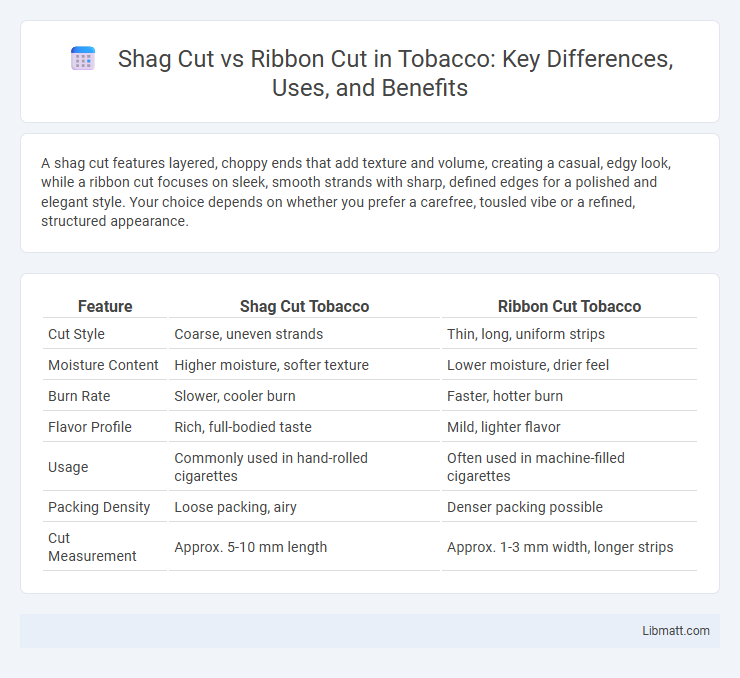A shag cut features layered, choppy ends that add texture and volume, creating a casual, edgy look, while a ribbon cut focuses on sleek, smooth strands with sharp, defined edges for a polished and elegant style. Your choice depends on whether you prefer a carefree, tousled vibe or a refined, structured appearance.
Table of Comparison
| Feature | Shag Cut Tobacco | Ribbon Cut Tobacco |
|---|---|---|
| Cut Style | Coarse, uneven strands | Thin, long, uniform strips |
| Moisture Content | Higher moisture, softer texture | Lower moisture, drier feel |
| Burn Rate | Slower, cooler burn | Faster, hotter burn |
| Flavor Profile | Rich, full-bodied taste | Mild, lighter flavor |
| Usage | Commonly used in hand-rolled cigarettes | Often used in machine-filled cigarettes |
| Packing Density | Loose packing, airy | Denser packing possible |
| Cut Measurement | Approx. 5-10 mm length | Approx. 1-3 mm width, longer strips |
Introduction to Shag Cut and Ribbon Cut
Shag cut features layered, textured hair designed to create volume and movement, often incorporating choppy ends for a tousled, effortless look. Ribbon cut involves precise, straight-edged layers that resemble ribbons, providing a sleek, polished appearance with defined structure. Both cuts offer distinct styling benefits suited to different hair types and aesthetic preferences.
Key Differences Between Shag Cut and Ribbon Cut
The shag cut features layered, textured hair with varied lengths creating volume and movement, while the ribbon cut is characterized by sleek, straight strands with a uniform length that emphasizes smoothness and shine. Shag cuts often utilize choppy edges and feathered ends for a casual, tousled look, whereas ribbon cuts focus on precision and polish for a refined appearance. Styling techniques differ as shag cuts embrace a messy, effortless vibe, contrasting with the ribbon cut's demand for sleek, tightly controlled finishes.
Historical Origins of Each Hairstyle
The shag cut originated in the 1970s, popularized by rock stars and Hollywood icons who embraced its layered, textured look for effortless volume and movement. The ribbon cut, with roots in traditional African hairstyling methods, involves wrapping hair with ribbons or bands, symbolizing cultural identity and heritage. Understanding the historical origins of each, you can appreciate how the shag cut reflects a rebellious, free-spirited era, while the ribbon cut celebrates cultural significance and intricate craftsmanship.
Face Shapes Suited for Shag Cut vs Ribbon Cut
Shag cuts suit oval, round, and heart-shaped faces by adding volume and texture that balance facial features and soften jawlines. Ribbon cuts complement square and long face shapes, enhancing angular structures with sleek, defined layers that frame the face. Both styles offer adaptable options to accentuate natural contours, with shag cuts emphasizing a tousled look and ribbon cuts providing smooth, polished edges.
Styling Techniques for Shag Cut
Styling techniques for a shag cut focus on enhancing its textured layers through the use of sea salt sprays, texturizing creams, and blow-drying with a diffuser to boost natural volume and movement. You can create a tousled, effortless look by scrunching damp hair or using a flat iron to define the choppy ends for added edge. Unlike ribbon cuts, which emphasize sleek, smooth strands, shag cuts thrive on a lived-in, piecey appearance that highlights individual layers and dimension.
Styling Techniques for Ribbon Cut
Ribbon cut hair requires precise sectioning and the use of a fine-tooth comb to create those defined, flat strands that resemble ribbons. To enhance your ribbon cut, utilize a flat iron for sleek straightening and finish with a lightweight serum to maintain shine and reduce frizz. Styling tools that emphasize smoothness and structure are key to keeping the ribbon cut looking polished and distinct.
Maintenance and Upkeep Comparison
Shag cuts require regular trims every 6 to 8 weeks to maintain their layered texture and avoid a bulky appearance, while ribbon cuts need less frequent touch-ups, typically every 8 to 12 weeks, to preserve their sleek, straight edges. Shag hairstyles often demand more daily styling with texturizing products and heat tools to enhance volume and separation, whereas ribbon cuts benefit from minimal styling, focusing on smoothness with occasional use of smoothing serums or straighteners. Overall, shag cuts involve higher maintenance efforts and costs due to the need for frequent salon visits and styling, whereas ribbon cuts offer a lower-maintenance, polished look suitable for those preferring simplicity.
Celebrity Inspirations: Shag vs Ribbon Styles
The shag cut, popularized by celebrities like Jane Fonda and Taylor Swift, features choppy layers that create a textured, voluminous look ideal for dynamic, effortless styles. Ribbon cuts, favored by stars such as Selena Gomez and Zendaya, emphasize smooth, sleek strands with defined, straight edges that highlight shine and precision. Both hairstyles transform personal expression through distinct layering techniques, influencing fashion trends with their iconic celebrity endorsements.
Pros and Cons of Shag Cut and Ribbon Cut
Shag cuts offer textured layers that add volume and effortless movement, making them ideal for those seeking a low-maintenance, modern style, but they may not suit very fine hair as the layers can create unevenness. Ribbon cuts provide straight, sleek ends that give hair a polished, structured look, perfect for maintaining length and precision, yet they may require frequent trims to keep the sharp edges intact and can highlight split ends more easily. Choosing between your shag cut or ribbon cut depends on your hair type and desired upkeep, balancing volume and texture against smoothness and definition.
Choosing the Right Cut for Your Hair Type
Shag cuts work best for medium to thick hair, adding volume and texture to naturally wavy or straight strands, while ribbon cuts suit fine or thin hair by creating sleek, sharp layers that enhance length and smoothness. For curly hair, a shag cut enhances natural bounce without weighing the curls down, whereas ribbon cuts can help define curls with more structured layering. Understanding your hair's texture and density ensures choosing between these cuts optimizes styling ease and highlights your hair's natural movement.
Shag cut vs Ribbon cut Infographic

 libmatt.com
libmatt.com